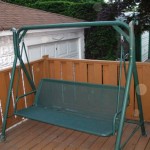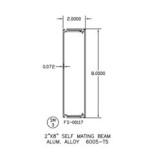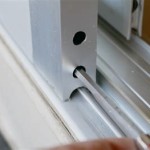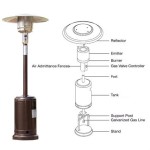Patio Door Lock Not Working
A malfunctioning patio door lock can be a significant security concern and a source of frustration. Understanding the common causes and solutions can help homeowners troubleshoot the issue and potentially avoid costly repairs. This article explores several reasons why a patio door lock might fail and provides practical steps for addressing the problem.
Misaligned Latch
One of the most frequent causes of a patio door lock malfunction is a misaligned latch. The latch is the metal bolt that extends from the door into the strike plate on the door frame. Over time, the door can shift due to settling of the house or changes in humidity, causing the latch to no longer align correctly with the strike plate. This misalignment prevents the door from locking properly.
To check for misalignment, observe the latch as the door is closed. If it doesn't smoothly enter the strike plate or appears to be catching, misalignment is likely the culprit. Minor misalignment can often be corrected by adjusting the strike plate. Loosening the screws holding the strike plate allows for slight repositioning. More significant misalignment might require adjusting the door itself, which may involve tightening or loosening hinges.
Worn-Out Lock Mechanism
The internal mechanisms of a patio door lock can wear out with regular use. The constant sliding and locking action can cause components within the lock to become damaged or broken. This can manifest in a variety of ways, such as a key that doesn't turn smoothly, a handle that feels loose, or a lock that simply refuses to engage.
Identifying a worn-out lock mechanism often involves inspecting the lock itself. Look for signs of wear, damage, or broken parts. If the internal components are significantly worn, replacing the entire lock mechanism is usually the most effective solution.
Obstructed Track
Sliding patio doors operate on a track. Dirt, debris, or even small objects can accumulate in the track, hindering the door's movement and preventing it from closing and locking properly. A build-up of debris can also put extra strain on the lock mechanism, accelerating wear and tear.
Regularly cleaning the track is essential for maintaining smooth door operation. Use a vacuum cleaner or brush to remove loose debris. Stubborn dirt can be dislodged with a stiff brush and a cleaning solution. Lubricating the track after cleaning will further enhance smooth operation and reduce strain on the locking mechanism.
Faulty Locking Handle
The locking handle itself can sometimes be the source of the problem. The mechanism within the handle can break or become dislodged, preventing the lock from engaging. This can result in a handle that feels loose or doesn't operate smoothly.
Inspect the locking handle for any visible signs of damage or looseness. Try to operate the handle and observe if it engages the lock mechanism correctly. If the handle is faulty, replacing it is typically the necessary course of action. Most hardware stores carry replacement handles for various patio door models.
Broken Key
While less common than other issues, a broken key can certainly prevent a patio door from locking. If a key breaks off inside the lock cylinder, it obstructs the mechanism and prevents the lock from functioning correctly. Attempting to force the lock or use another key can worsen the problem.
Extracting a broken key requires careful manipulation. Using needle-nose pliers or a specialized key extractor tool can sometimes be successful. If the broken key cannot be removed easily, contacting a locksmith is recommended to avoid further damage to the lock.
Weather Stripping Interference
Weather stripping creates a seal around the door to prevent drafts and improve energy efficiency. However, if the weather stripping becomes compressed, worn, or misaligned, it can interfere with the door's closing and locking action. The added pressure from the weather stripping can prevent the latch from engaging correctly.
Inspect the weather stripping around the door frame. Look for signs of damage, compression, or misalignment. If the weather stripping is hindering the door's operation, it may need to be adjusted or replaced. Ensuring proper weather stripping alignment will restore smooth door operation and allow the lock to function correctly.
Security Concerns
A malfunctioning patio door lock poses a security risk. Addressing the issue promptly is crucial to maintaining the security of the home. If troubleshooting steps don't resolve the problem, contacting a qualified locksmith or door repair specialist is advisable. A professional can diagnose the issue accurately and implement the necessary repairs to restore the door's security.

Fix A Sliding Glass Door That Won T Lock Or Latch Easy

My Patio Door Won T Lock What Do I Checkatrade

My Patio Door Won T Lock What Do You

How To Replace A Sliding Glass Door Latch Patio Replacement Won T Lock

How To Replace Sliding Door Lock Handle Easy Simple Latch

Anderson Sliding Glass Door Not Locking Adjust

Broken Sliding Door Lock Sgd R20 Swisco Com

Solving Common Sliding Glass Door Lock Problems Fs Blog

Sliding Patio Glass Door Not Locking Diy Fix

How To Fix Upvc Door Lock Problems And Prevention Iks Locksmiths
Related Posts








